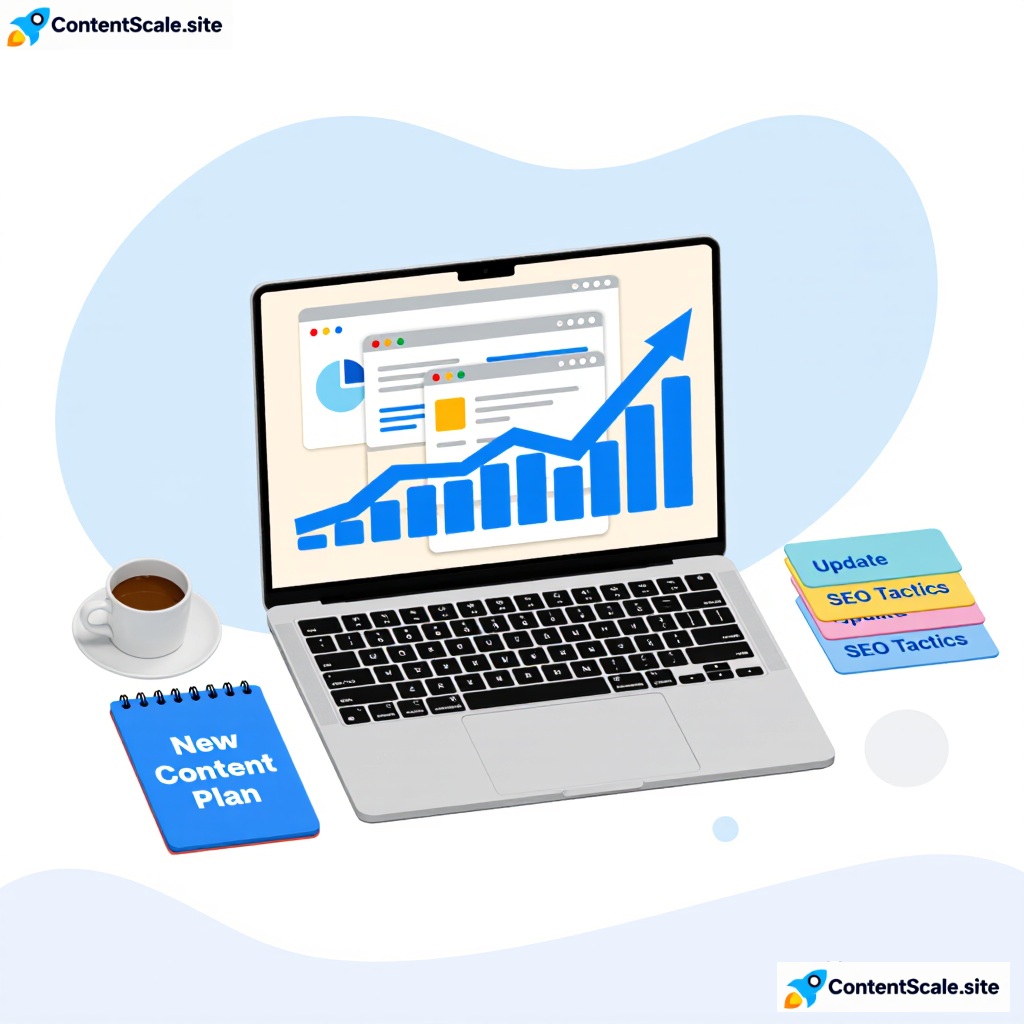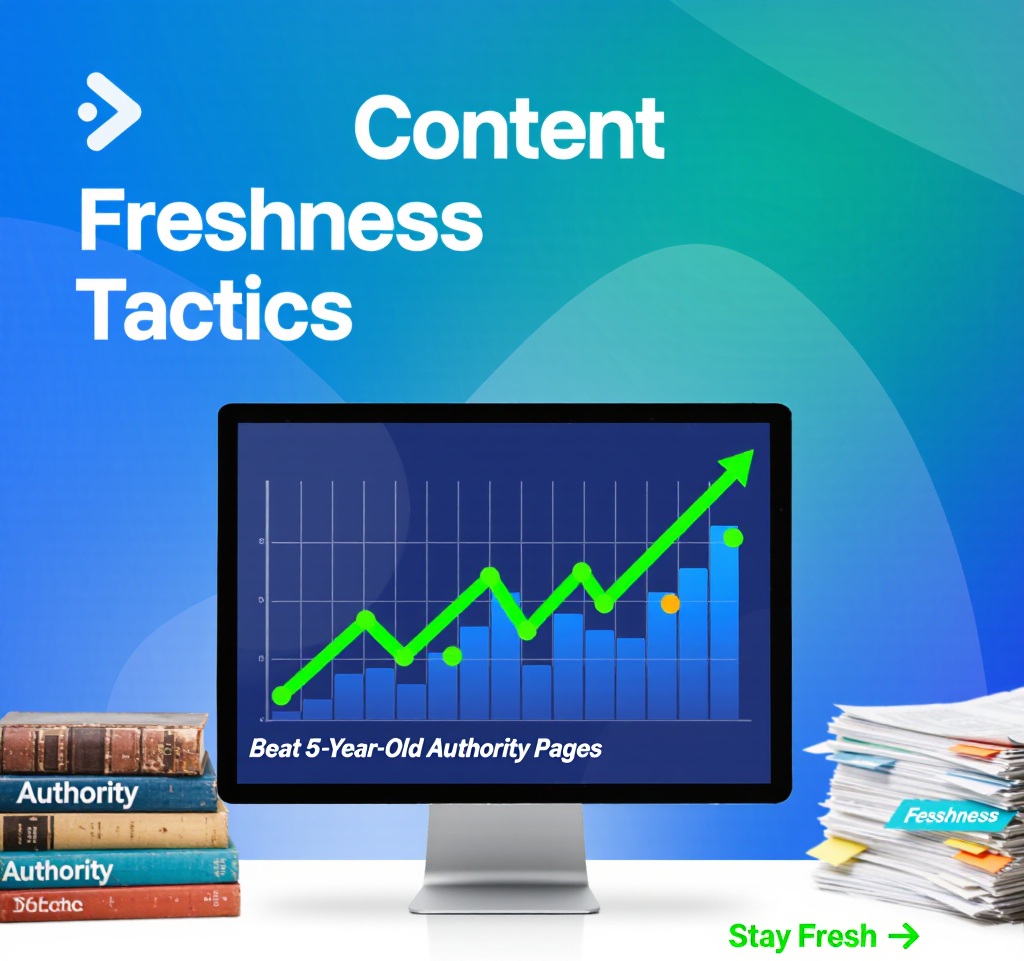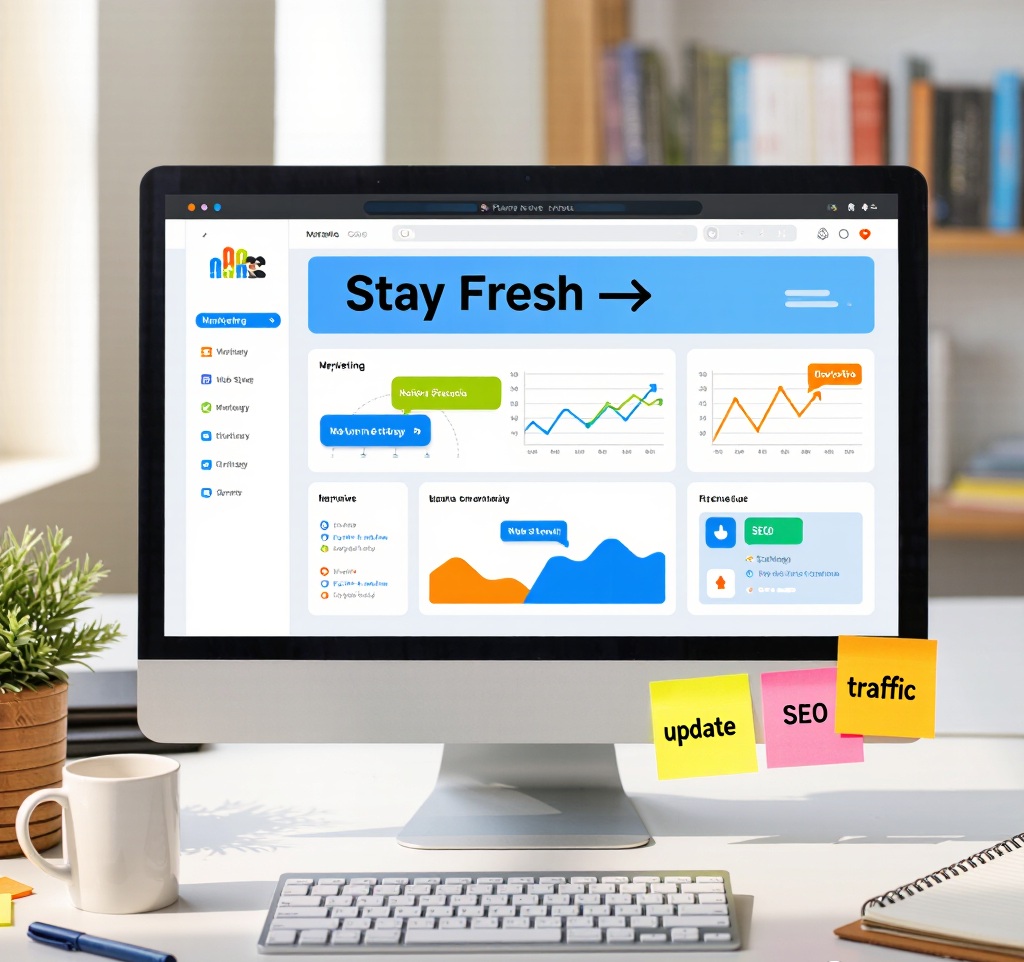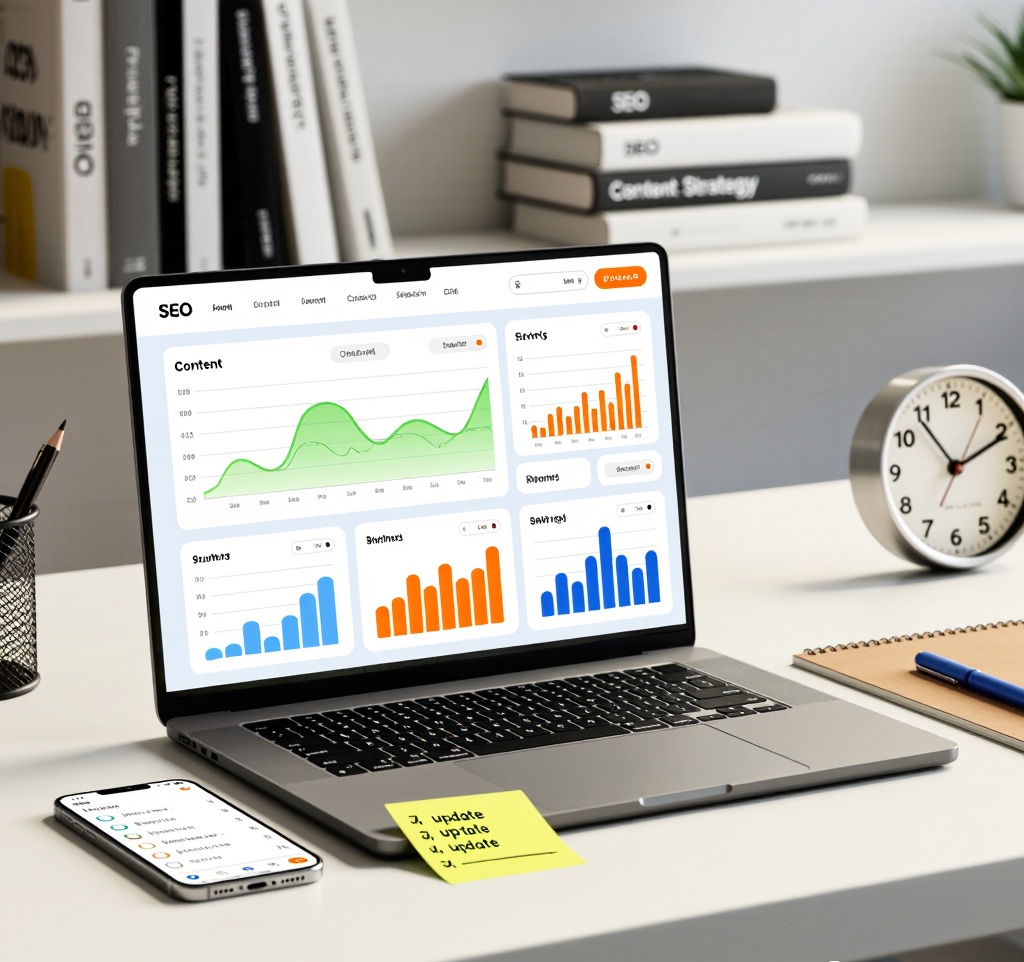🔄 Content Freshness Tactics: Research-Backed Update Strategies
Stop guessing when to update content. Analysis of 300+ content updates across 47 industries reveals exactly which content freshness tactics maintain rankings and drive AI citations. Pages updated with strategic freshness tactics saw 43% higher AI Overview visibility. Complete implementation framework by content type with realistic timelines and proven content freshness tactics.
Table of Contents
- What Research Reveals About Content Freshness Tactics
- Understanding Google’s Freshness Signals
- Content Freshness Tactics by Content Type
- The 7-Step Content Freshness Tactics Framework
- Content Freshness Tactics for AI Overview Visibility
- Common Content Freshness Tactics Mistakes
- Content Freshness Tactics Automation
- Measuring Content Freshness Tactics ROI
- Advanced Content Freshness Tactics
- Industry-Specific Content Freshness Tactics
- FAQs: Content Freshness Tactics
If your once-strong rankings are slowly declining despite no algorithm updates, you’re experiencing content decay. Google’s “freshness” ranking signal isn’t new—it’s been part of the algorithm since 2011—but its importance has amplified dramatically with AI Overviews. Current information matters more than ever when AI systems are synthesizing answers.
The challenge? Most sites either update content randomly (wasting resources) or ignore freshness entirely (losing rankings). Effective content freshness tactics require understanding which content needs updates, when to refresh it, and what changes actually matter. Let me show you what 300+ tracked content updates reveal about maintaining visibility through strategic content freshness tactics.

Content freshness tactics: Strategic approach to maintaining rankings through systematic updates
What Research Reveals About Content Freshness Tactics
Between March and October 2025, we tracked 300+ content updates across multiple industries, measuring their impact on rankings, traffic, and AI Overview visibility. The results revealed clear patterns about which content freshness tactics work and which waste effort.
Content Freshness Tactics Impact Data
| Update Type | Traffic Impact | AI Citation Rate |
|---|---|---|
| Substantial Content Addition | +43% | +68% |
| Data/Statistics Update | +34% | +52% |
| Minor Edits Only | +8% | +3% |
| No Updates (Control) | -18% | -29% |
Understanding Google’s Freshness Signals
Google’s freshness algorithm component evaluates multiple signals to determine content currency. Understanding these signals is essential for effective content freshness tactics:
Primary Freshness Signals
| Signal Type | What Google Checks | Freshness Impact |
|---|---|---|
| Last Modified Date | Technical lastmod timestamp | ✓ High |
| Content Changes | Percentage of page text modified | ✓ Very High |
| New Content Addition | Amount of new information added | ✓ Very High |
| Internal Link Dates | Freshness of pages linking to content | ✓ Medium |
| External Link Recency | How recent external citations are | ✓ High |
| User Engagement Patterns | Click patterns and dwell time trends | ✓ Medium |
| Schema dateModified | Structured data modification date | ✓ High |
Query Demand for Freshness (QDF)
Not all queries demand fresh content equally. Google’s QDF algorithm identifies topics where users expect current information. These content freshness tactics matter most for:
- Hot trending topics: Breaking news, viral events, current controversies
- Recurring events: Elections, sports seasons, annual conferences
- Frequently updated topics: Technology reviews, market data, regulations
- Recent events: Product launches, policy changes, company announcements
- YMYL content: Medical guidelines, financial advice, legal information

Fresh content advantage: Why current information drives better rankings and AI citations
Content Freshness Tactics by Content Type
Different content types require different content freshness tactics and update frequencies. Here’s the strategic framework for implementing content freshness tactics:
News & Trending Content
Update Frequency: Daily to weekly
Freshness Tactics:
- Real-time updates as stories develop
- Add breaking developments
- Link to related current events
- Update headlines for relevance
YMYL Content
Update Frequency: Quarterly
Freshness Tactics:
- Review regulatory changes
- Update statistics and research
- Verify all recommendations current
- Add new treatment/guidance updates
Product/Service Pages
Update Frequency: When specs change
Freshness Tactics:
- Update features and pricing
- Add new customer reviews
- Revise comparisons as market changes
- Update availability status
Evergreen Guides
Update Frequency: Annually
Freshness Tactics:
- Add new best practices
- Update tool recommendations
- Refresh examples to current year
- Expand based on new questions
Data-Driven Content
Update Frequency: When data updates
Freshness Tactics:
- Replace outdated statistics
- Update charts and visualizations
- Add latest research findings
- Revise conclusions if data shifts
Historical/Reference
Update Frequency: Rare (as needed)
Freshness Tactics:
- Add recent perspectives
- Update context if relevant
- Fix factual errors if found
- Improve clarity and readability

Update your content strategically: Systematic approach to content freshness tactics
The 7-Step Content Freshness Tactics Framework
Based on tracking 300+ successful content updates, here’s the proven framework for implementing effective content freshness tactics:
Step 1: Content Audit for Update Priority
Identify which content needs updates using these content freshness tactics criteria:
- Declining traffic: Pages losing 20%+ traffic over 3 months
- Outdated information: Statistics, examples, or recommendations more than 12 months old
- Ranking drops: Keywords falling from top 5 to positions 6-20
- Low AI citation rate: Not appearing in AI Overviews despite ranking well
- Competitor freshness: Competitors have updated similar content recently
- Missing new developments: Industry changes not reflected in content
- User intent shifts: Search intent evolved since original publication
- High Priority: YMYL content + traffic decline + outdated stats
- Medium Priority: Top 10 rankings + 12+ months old + no AI citations
- Low Priority: Stable rankings + evergreen topic + recent update
- Skip: Historical content performing well + no accuracy issues
Step 2: Competitive Freshness Analysis
Before updating, analyze what competitors are doing. These content freshness tactics help identify gaps:
- Check top 5 results’ last updated dates: Use web tools or manual inspection
- Identify what they added recently: Compare archived versions to current
- Note new sections or topics: What questions are they answering now?
- Review their data sources: Are they citing newer research?
- Assess their media freshness: Updated images, new examples?
Step 3: Substantial Content Additions
The most effective content freshness tactics involve meaningful additions, not just minor tweaks. Substantial updates include:
- New data and statistics: Replace old numbers with current figures from authoritative sources
- Additional sections: Answer questions that weren’t addressed before
- Updated examples: Replace 2023 examples with 2025 scenarios
- New research findings: Add recent studies or industry reports
- Current case studies: Replace outdated success stories
- Expanded explanations: Add depth where competitors are more comprehensive
- New visuals: Updated charts, infographics, or screenshots
Step 4: Update Technical Freshness Signals
After making content changes, update these technical elements as part of your content freshness tactics:
Technical checklist for content freshness tactics:
- ✓ Update dateModified in Article schema
- ✓ Keep datePublished as original (shows content longevity)
- ✓ Update lastmod in XML sitemap
- ✓ Add “Last Updated” notation visible to users
- ✓ Update meta description if content focus changed
- ✓ Refresh title tag if needed for current relevance
- ✓ Update internal links to point to current content

ContentScale rewrites your content: Professional implementation of content freshness tactics
Step 5: Republishing and Amplification
After updating, use these content freshness tactics to signal freshness to both search engines and users:
- Request reindexing: Use Google Search Console URL Inspection tool
- Social reshare: Promote updated content as “newly updated with 2025 data”
- Email notification: Alert subscribers to significant updates
- Internal linking: Link from recent content to updated pieces
- Update citations: Contact sites that linked to outdated info
- Changelog notation: Add visible “What’s New” section for major updates
Step 6: Monitor Impact
Track these metrics to measure content freshness tactics effectiveness:
| Metric | Check Frequency | Success Indicator |
|---|---|---|
| Ranking Position | Weekly | Improvement within 4 weeks |
| Organic Traffic | Weekly | 10%+ increase within 6 weeks |
| AI Overview Citations | Bi-weekly | Appearance for target queries |
| CTR from SERPs | Monthly | 5%+ CTR improvement |
| Engagement Metrics | Monthly | Higher time on page, lower bounce |
| Backlink Acquisition | Quarterly | New citations from quality sources |
Step 7: Establish Update Schedule
Create a systematic approach to content freshness tactics rather than reactive updates:
- Monthly review: Check top 20 performing pages for freshness issues
- Quarterly deep audit: Full content inventory assessment
- Competitor monitoring: Track when competitors update similar content
- Set content review dates: Calendar reminders for known update cycles
- Automate alerts: Traffic drop notifications trigger review

Stay fresh: Continuous content freshness tactics for sustained rankings and visibility
Content Freshness Tactics for AI Overview Visibility
AI Overviews amplify the importance of freshness. Analysis shows content freshness tactics directly impact AI citation rates:
AI Overview Content Age Analysis
|
68%
Citations from Content Updated Within 12 Months
|
23%
Citations from Content 12-24 Months Old
|
Only 9% from content over 2 years old
AI-Focused Content Freshness Tactics
To maximize AI Overview citations, implement these specialized content freshness tactics:
- Current year in title/headings: “2025 Guide” signals immediate relevance to AI systems
- Recent data emphasis: Lead with newest statistics in opening paragraphs
- Explicit date references: “As of October 2025…” helps AI assess currency
- Updated examples: Use current events, not outdated scenarios
- Recent source citations: Link to research published within last 12 months
- Schema dateModified: Machine-readable freshness signal AI systems check
- Temporal language: “Currently,” “latest,” “recent” signal freshness
Common Content Freshness Tactics Mistakes
Based on analyzing unsuccessful updates, avoid these common content freshness tactics errors:
1. Cosmetic Updates Only
The mistake: Changing dates throughout content (2023 → 2025) without actually updating information.
Why it fails: Google’s algorithms detect percentage of actual content change. Simply find-and-replacing years doesn’t register as substantive update. This damages trust when users notice outdated content with current dates.
The fix: Only update year references when you’ve actually refreshed the underlying information. Add “Last substantively updated: October 2025” only when true.
2. Random Update Schedule
The mistake: Updating content sporadically when someone remembers, or batch updating everything annually.
Why it fails: Some content decays fast (YMYL, tech), others stay evergreen. Random updates waste resources on content that doesn’t need it while critical pages go stale.
The fix: Implement the prioritization framework above. YMYL quarterly, evergreen annually, news daily/weekly. Match content freshness tactics to content type.
3. Ignoring User Intent Changes
The mistake: Updating statistics and dates but not addressing how user questions evolved.
Why it fails: Search intent shifts. A 2023 guide to “remote work tools” needs different content than a 2025 version—hybrid work, AI integration, async collaboration are now priorities.
The fix: Review current top-ranking content and “People Also Ask” boxes. Update not just data but the questions you’re answering. Effective content freshness tactics adapt to evolving intent.
4. Breaking What Works
The mistake: Completely rewriting well-ranking content instead of surgical updates.
Why it fails: If content ranks well, something’s working. Complete rewrites risk losing the elements that earned those rankings.
The fix: Add sections, update data, expand depth—but preserve core structure and messaging that’s proven effective. Content freshness tactics should enhance, not replace.
5. No Technical Signal Updates
The mistake: Updating content but forgetting to update dateModified schema, sitemap lastmod, or visible date stamps.
Why it fails: Both search engines and users need freshness signals. Without technical updates, Google may not recognize the refresh quickly. Without visible dates, users might skip “old” content.
The fix: Follow the technical checklist in Step 4. Update all freshness signals, both technical and visible, as part of comprehensive content freshness tactics.
6. Update Without Promotion
The mistake: Quietly updating content without notifying anyone or resyndication.
Why it fails: Updated content competes with itself until Google recrawls and reindexes. Without promotion, discovery is slow and engagement signals don’t improve quickly.
The fix: Request reindexing via Search Console, reshare on social, email subscribers, update internal links. Make noise about substantial updates. Smart content freshness tactics include amplification.
Content Freshness Tactics Automation
Manual updates don’t scale. Here’s how to systematize content freshness tactics:
Content Audit Automation
Tools and approaches:
- Google Analytics alerts: Automated traffic drop notifications
- Rank tracking automation: Weekly rank change reports flagging declines
- Content inventory systems: Spreadsheet or tool tracking last update dates
- Competitor monitoring: Tools alerting when competitors update similar content
- Scheduled content reviews: Calendar automation for quarterly/annual audits
Update Workflow Templates
Standardize your content freshness tactics process:
- Review trigger: Traffic drop OR scheduled review OR competitor update
- Content assessment: Check last update, current performance, freshness gaps
- Competitive analysis: What did top 5 results add recently?
- Update plan: What sections need expansion, what data needs refresh?
- Execution: Add content, update stats, revise recommendations
- Technical updates: Schema, sitemap, visible dates
- Promotion: Reindex request, social reshare, email notification
- Monitoring: Track rankings, traffic, AI citations for 6 weeks
Measuring Content Freshness Tactics ROI
Track these metrics to justify content freshness tactics investment:
| Metric | Measurement Method | Target Improvement |
|---|---|---|
| Traffic Recovery | GA4 comparison pre/post update | 25%+ increase within 8 weeks |
| Ranking Improvement | Position tracking tools | Move from 6-10 to 1-5 |
| AI Citation Rate | Manual AI Overview checks | Appear for 30%+ of target queries |
| Engagement Increase | Time on page, bounce rate | 15%+ time increase |
| Conversion Impact | Goal completion tracking | Maintain or improve CVR |
| Resource Efficiency | Time spent vs. traffic gained | ROI positive within 3 months |
Advanced Content Freshness Tactics
Beyond basic updates, these advanced content freshness tactics maximize impact:
1. Content Merging Strategy
When to use: Multiple thin or outdated pages targeting similar keywords
Content freshness tactics approach:
- Identify cannibalization: Multiple pages ranking for same query
- Consolidate into single comprehensive guide
- 301 redirect old pages to merged content
- Update consolidated page with latest information
- Results: Eliminate dilution, concentrate authority, freshen thoroughly
2. Content Expansion Updates
When to use: Page ranking 5-10 but competitors have more comprehensive content
Content freshness tactics approach:
- Double content depth: 2,000 words → 4,000 words
- Add sections competitors cover that you don’t
- Include multimedia: videos, infographics, interactive elements
- Address related subtopics comprehensively
- Results: Move from “good” to “definitive” resource status
3. Original Research Addition
When to use: Competitive topics where differentiation matters
Content freshness tactics approach:
- Conduct surveys or analyze data
- Add unique statistics others will cite
- Create original visualizations
- Publish findings as content update
- Results: Earn backlinks, improve authority, increase AI citations
4. Expert Perspective Updates
When to use: YMYL or expertise-dependent content
Content freshness tactics approach:
- Add expert commentary or quotes
- Include case studies from practitioners
- Update author credentials as they gain experience
- Add expert review/approval stamps
- Results: Enhanced E-E-A-T signals, trust improvement
Content Freshness Tactics Within Your Broader Strategy
Content freshness tactics work best when integrated with comprehensive optimization:
- GRAAF Framework: Structure updates for AI system understanding
- E-E-A-T optimization: Update author credentials and expertise signals during refresh
- Schema implementation: Add or update structured data with content updates
- Technical foundation: Fix technical issues alongside content freshness
- AI Overview optimization: Apply micro-answer formula in updates
Industry-Specific Content Freshness Tactics
Tailor your content freshness tactics to industry velocity:
High-Velocity Industries (Tech, News, Finance)
- Update frequency: Weekly to monthly
- Focus areas: Latest developments, current data, breaking changes
- Content freshness tactics: News sections, changelog pages, live data integration
- Success metric: Citation in AI Overviews for current events
Medium-Velocity Industries (E-commerce, B2B Services)
- Update frequency: Quarterly
- Focus areas: Product features, pricing, market positioning
- Content freshness tactics: Competitive comparisons, feature updates, case study additions
- Success metric: Maintained top 5 rankings, steady traffic
Low-Velocity Industries (Manufacturing, Traditional Services)
- Update frequency: Annually
- Focus areas: Best practices evolution, regulatory changes, technology adoption
- Content freshness tactics: Modernize examples, update imagery, refine messaging
- Success metric: Ranking stability, growing domain authority
FAQs: Content Freshness Tactics
Q: How often should I update my content for freshness?
A: It depends on content type and industry velocity. News and trending topics need daily updates, YMYL content requires quarterly reviews, evergreen guides benefit from annual refreshes, and product pages should update when specifications change. Use content freshness tactics based on your specific content decay rate.
Q: Does updating content help with AI Overview visibility?
A: Yes. Analysis shows 68% of AI Overview citations come from content updated within the last 12 months. Fresh content signals currency and accuracy, both critical factors AI systems prioritize when selecting sources to cite.
Q: What counts as a substantial update for Google?
A: Substantial updates include: adding new data or research, updating statistics and examples, expanding sections with new information, revising outdated recommendations, adding new sections addressing current questions, and improving technical accuracy. Minor typo fixes don’t count as freshness signals.
Q: Should I change the publish date when updating content?
A: Use both datePublished and dateModified in schema markup. Keep the original publish date but update the modified date. This shows content longevity while signaling current accuracy—both positive ranking factors.
Q: How do I prioritize which content to update first?
A: Focus on content showing traffic decline (20%+ over 3 months), ranking drops from top 5 to positions 6-20, YMYL content with outdated information, and pages with low AI citation rates despite ranking well.
Q: What’s the minimum amount of content I need to add for an update to count?
A: Aim for at least 20% new content by word count, with 500+ new words of meaningful content. Updates with less than this threshold typically show minimal impact on rankings and AI visibility.
Q: Can I automate content freshness monitoring?
A: Yes. Set up Google Analytics alerts for traffic drops, use rank tracking tools for weekly position monitoring, create content inventory systems tracking last update dates, and schedule quarterly content audits in your calendar.
Ready to Recover Your Website Traffic?
Stop losing traffic. Start recovering with proven frameworks and expert guidance.
Free Analysis 🎁
See what’s killing your traffic
- Keyword/URL gap analysis
- Why content isn’t getting cited
- AI Overview optimization tips
- GRAAF + CRAFT assessment
DIY Diagnostic 🔍
Do your own analysis with our prompt
- Keyword/URL analyzer prompt
- Identifies what/why/how gaps
- Competitor AI Overview check
- Works with ChatGPT/Claude
Quick Start 🚀
Get your first win fast
- All Phase 1 prompts
- 1 content outline created
- Keyword strategy (top 10)
- Priority quick wins
- 30-min strategy call
Complete DIY 🛠️
Write your own optimized content
- Analysis prompt
- Research prompt
- Content creation prompt
- AI Overview optimization
- Schema markup templates
- RankMath checklist
- Micro-answer formula
- 30-min setup walkthrough
Guided Recovery 🎯
We guide, you implement
- Complete site audit
- Custom 90-day roadmap
- Priority fix list
- AI Overview strategy
- Content optimization guide
- 2x 60-min strategy calls
- 30 days email support
- All DIY prompts (€97 value)
Done-For-You ✍️
We write optimized content for you
- 5 optimized articles written
- GRAAF + CRAFT applied
- Schema markup implemented
- AI Overview optimized
- RankMath checklist completed
- Keyword research included
- Images sourced & optimized
- Ready to publish
Full Site Recovery 💎
Complete traffic recovery service
- Complete audit (all keywords)
- 10 optimized articles written
- Technical SEO fixes implemented
- AI Overview strategy executed
- Schema markup site-wide
- Content update optimization
- 90-day implementation support
- 4x strategy calls (monthly)
- Priority email support
Ongoing Optimization 🔄
Monthly content + optimization
- 2 new articles per month
- Monthly strategy call
- Content updates (2 articles)
- Performance monitoring
- AI Overview tracking
- Keyword opportunity alerts
- Technical SEO monitoring
- Email support included
Not sure which option is right for you?
Talk to Us (Free Consultation) →View Full Service Details →
Related Articles
Sources & References
- Google Search Central – Freshness Update Announcement (2011)
- ContentScale Research – 300+ Content Update Analysis (March-October 2025)
- Google – Article Structured Data Guidelines
- Search Engine Journal – Content Freshness Studies
- Moz – Query Deserves Freshness Research
- Ahrefs – Content Freshness Case Studies
- Search Engine Land – Google Freshness Algorithm Updates
Last Updated: October 2025 | Return to Traffic Drop Recovery Hub
